Fascinated In Recognizing The Warning Lights On Your Cars And Truck'S Control Panel? Discover Their Relevance For Your Lorry'S Safety And Security And Total Problem
Fascinated In Recognizing The Warning Lights On Your Cars And Truck'S Control Panel? Discover Their Relevance For Your Lorry'S Safety And Security And Total Problem
Blog Article
Short Article Created By-Sykes Gilbert
When you lag the wheel, those glowing warning lights on your control panel can be a little bit complicated. Do you recognize what they're attempting to inform you about your automobile's health? Understanding the value of these lights is vital for your safety and security and the long life of your car. So, the next time among those lights appears, wouldn't you intend to decode its message properly and take the required actions to address it?
Common Warning Lighting and Interpretations
Recognize common caution lights in your cars and truck and recognize their significances to guarantee risk-free driving.
The most normal caution lights consist of the check engine light, which signifies problems with the engine or exhausts system. If this light begins, it's crucial to have your vehicle inspected without delay.
The oil stress advising light indicates reduced oil pressure, calling for instant interest to avoid engine damages.
A blinking battery light might suggest a malfunctioning charging system, potentially leaving you stranded otherwise addressed.
The tire pressure tracking system (TPMS) light signals you to reduced tire stress, influencing car security and gas effectiveness. Overlooking this can result in hazardous driving conditions.
discover this shows a problem with the anti-lock braking system, compromising your capacity to stop quickly in emergency situations.
Last but not least, the coolant temperature level warning light warns of engine overheating, which can cause severe damages if not resolved quickly.
Comprehending these typical caution lights will certainly help you attend to issues without delay and maintain safe driving conditions.
Relevance of Prompt Focus
Recognizing the typical caution lights in your vehicle is only the very first step; the value of without delay attending to these warnings can not be highlighted sufficient to ensure your safety when driving.
When a caution light brightens on your control panel, it's your cars and truck's way of communicating a prospective concern that requires attention. Neglecting these warnings can cause more severe problems down the road, compromising your safety and potentially costing you extra in repairs.
Motivate focus to warning lights can prevent breakdowns and accidents. As an example, a blinking check engine light might suggest a misfire that, if left neglected, could cause damage to the catalytic converter. Addressing this without delay can save you from an expensive repair work.
Likewise, a brake system alerting light may signify low brake fluid or used brake pads, vital parts for your security when driving.
Do It Yourself Troubleshooting Tips
If you notice a caution light on your control panel, there are a few do it yourself troubleshooting pointers you can try before seeking specialist help.
The very first step is to consult your car's guidebook to recognize what the particular warning light suggests. Occasionally the concern can be as straightforward as a loose gas cap setting off the check engine light. Tightening up the gas cap may deal with the problem.
Another typical issue is a low battery, which can activate various warning lights. Inspecting the battery links for corrosion and guaranteeing they're safe and secure could fix the trouble.
If a warning light lingers, you can attempt resetting it by disconnecting the vehicle's battery for a couple of mins and after that reconnecting it. In addition, inspecting your car's liquid degrees, such as oil, coolant, and brake liquid, can help fix advising lights associated with these systems.
Conclusion
To conclude, recognizing your auto's warning lights is vital for maintaining your car running efficiently and safely. By promptly addressing these informs and understanding what they indicate, you can prevent expensive fixings and prospective malfunctions.
Keep in mind to consult your automobile's guidebook for particular information on each cautioning light and act as necessary to make certain a trouble-free driving experience.
Remain educated, stay risk-free on the road!
